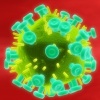 A new book -- The Origins of AIDS by Jacques Pépin, MD, an infectious disease specialist -- speculates that the spread of HIV can be traced back to about 80 chimpanzees in Africa that infected about three bush-meat hunters circa 1921.
A new book -- The Origins of AIDS by Jacques Pépin, MD, an infectious disease specialist -- speculates that the spread of HIV can be traced back to about 80 chimpanzees in Africa that infected about three bush-meat hunters circa 1921.There are many twists and turns in the story, but one of the pivot points is Haiti. Pépin claims that the specific type of HIV most prevalent in the West -- subgroup B, group M, HIV-1 -- arrived in Haiti in one man around 1966.
Further, he claims that sex alone could not have spread it so far and so wide so quickly. As a result, it needed help.
An excerpt from the New York Times review of the book explains:
[Pépin] believes the culprit was a Port-au-Prince plasma center called Hemo-Caribbean that operated only from 1971 to 1972 and was known to have low hygiene standards.
Plasma centers take blood, spin it and return the red cells. If new tubing isn’t used for each patient, infections spread. Sloppy plasma operations caused later HIV outbreaks in Mexico, Spain and India and, most famously, in rural China, where 250,000 sellers were infected.
Hemo-Caribbean’s co-owner was Luckner Cambronne, leader of the feared Tontons Macoutes secret police. Nicknamed the “Vampire of the Caribbean,” Cambronne, who died in 2006, bled 6,000 sellers who were paid as little as $3 a day and exported 1,600 gallons of plasma to the United States each month, according to an article in The New York Times.
Haiti was also a prime destination for gay American sex tourists; the Spartacus travel guides described how much young men expected to be paid. By the early 1980s, subgroup B was killing both American homosexuals and hemophiliacs, suggesting it arrived via both routes. The modern history of AIDS had begun.
Moral of this story? Truth is always scarier than fiction, even on Halloween.







Comments
Comments